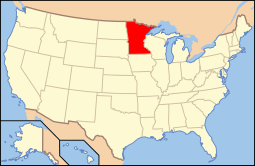Washburn Park Water Tower
|
Washburn Park Water Tower | |
|
The Washburn Park Water Tower from the southeast | |
| Location | Minneapolis, Minnesota |
|---|---|
| Coordinates | 44°54′38.76″N 93°17′2.45″W / 44.9107667°N 93.2840139°WCoordinates: 44°54′38.76″N 93°17′2.45″W / 44.9107667°N 93.2840139°W |
| Built | 1931 |
| Architect | Harry W. Jones |
| NRHP Reference # | 83003663 [1] |
| Added to NRHP | October 6, 1983 |
The Washburn Park Water Tower poses as a landmark of early 20th-Century architectural achievement within the Tangletown neighborhood in south Minneapolis, Minnesota, and has been doing so for nearly 75 years. Perched on top of one of the highest points in south Minneapolis, the tower is given the privilege to boast its unique location and role as an unofficial "beacon" for incoming planes landing at Minneapolis-Saint Paul International Airport, yet remains hidden from much of the residents and visitors that pass by the base of the hill each day. This is mainly because large homes and tall oak trees scatter the hillside where the tower resides, and even more so, because of the clustered mess of streets and dead ends that compromise the towers' occupancy. Hence the name, 'Tangletown'.
The Washburn Park Water Tower is one of three stone water towers built in Minneapolis during the early 20th-Century. The others are Kenwood Park Water Tower, just west of downtown, and Prospect Park Water Tower, in southeast Minneapolis.
Early history
(This information is taken directly from the plaque at the site. It was erected in 2000 by the Tangletown Neighborhood Association.)
The history of the water tower, and of an earlier tower on this site, is closely linked to the Washburn brothers, Caldwallader and William, who initiated the development of the Washburn Park known also as Tangletown.
The original tower was built 1893 to supply water for the Memorial Orphan Asylum by the Washburn brothers, Cadawallder and William. Water was pumped from nearby Minnehaha Creek to the tower and the piped to the orphanage at the site where Ramsey Middle school stands today at 50th and Nicollet.The tower was then purchased by the city of Minneapolis and connected to the city water supply in 1915.
The tower you see, built in 1932 by the City of Minneapolis, was designed by these professional, who lived in the neighborhood.
Architect: Harry Wild Jones
Sculptor: John K. Daniels
Construction Engineer: William S Hewett
This 110-foot-high tower can hold 1,350,000 gallons nearly eight times the capacity of the old tower. It is drained in the fall and filled in the spring to provide a local head for water pressure throughout south Minneapolis during the summer/
Since 1983, the Washburn Water Tower has been listed on the National Register of Historic Places, in recognition of its unique design and monumental sculptures of eagles and the Guardians of Health.
As John Olson, president of OLSON, a Minneapolis-based advertising, interactive and PR agency, put it, "It's as good a landmark and touchstone -- and so, maybe, headstone -- as a body can expect from his hometown." Perhaps that's also what Harry Wild Jones had in mind in 1932 when he first put this masterpiece onto paper. Jones, a well-known Minneapolis architect who also designed Butler Square and Lakewood Cemetery Chapel (both of which are in Minneapolis), was well ahead of his time in creating the structurally sound Washburn Park Water Tower. Along with William S. Hewett (an engineer from the Interlachen Bridge project), the two men not only implemented modern hydro-engineering methods to the tower's design, but also its very own unique character. The story goes that as Jones was clearing underbrush at his home nearby, which was also in its construction phase, a giant eagle (with nearly an 8-foot (2.4 m) wingspan) had attacked him. He had the eagle maimed, captured, and brought to town where it began attracting much attention. In part, he used the eagle's extraordinary dimensions (and the artistic skills of John Karl Daniels) to cast eight concrete look-alikes, that now sit atop the tower to watch over their former domain. In addition, eight 18-foot-tall (5.5 m) "Guardians of Health" were placed around the tower (one under each eagle), to prevent any bad-tasting or bad-smelling water pollutants from contaminating the water supply, which were believed to be the cause of many typhoid fever outbreaks around that time. Jones's house is located near the tower. It is hard to see it because of trees and newer houses but at the right angles you can see parts of it. It looks old and castle like compared to other houses nearby
On October 6, 1983, the water tower was placed on the National Register of Historic Places for the city of Minneapolis. The water tower's record number is #24362.
References
- ↑ National Park Service (2006-03-15). "National Register Information System". National Register of Historic Places. National Park Service.
- Thomas, Katherine (July 1990). "Historic Watertowers". Explorer Rag. Archived from the original on 2006-03-06. Retrieved 2007-01-31.
- Olson, John (January 21, 2005). "John Olson: This tower is a reservoir of our common stories". Washburn High School (MN) Homepage. Retrieved 2007-01-31.
- Archiplanet.org. "Washburn Park Water Tower Location". Retrieved 2007-02-06.
- Emporis.com. "Washburn Park Water Tower Information". Retrieved 2007-02-06.
External links
| Wikimedia Commons has media related to Washburn Park Water Tower. |


